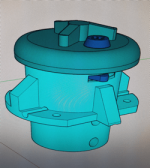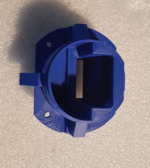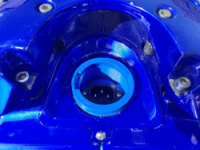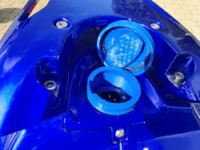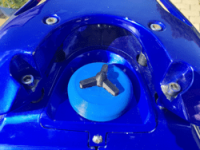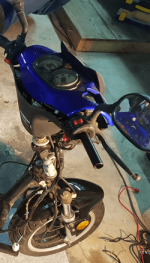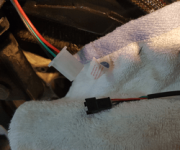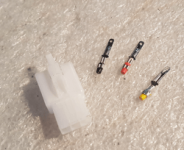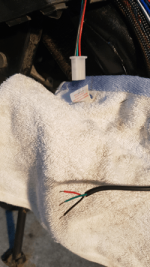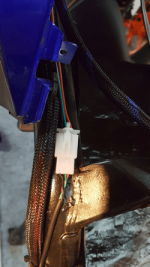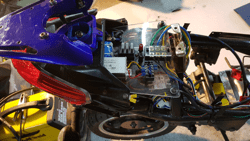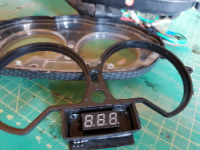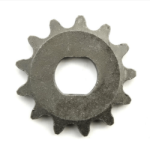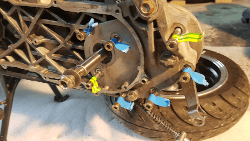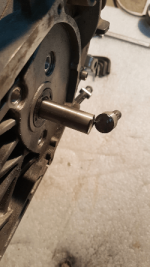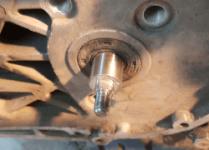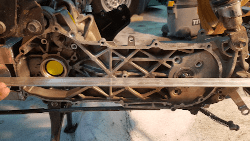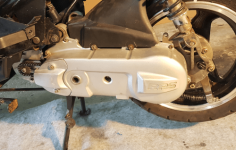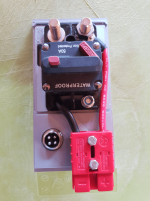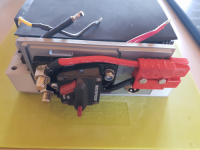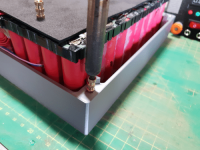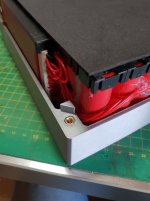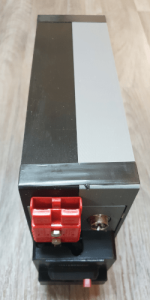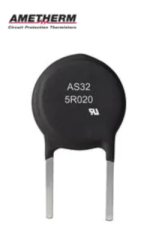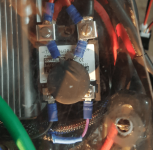3DRoboGuy
10 mW
This week I've been busy with the last major part of the conversion: siting the controller and associated components.
The original ICE kit has been removed.
The original wiring has been serviced / repaired / updated to remove no-longer required cabling and modified to re-task cabling to suit the new electrics and add any new / additional cabling for the imminent electric conversion.
The 3Kw BLDC electric motor has been fitted on a custom, adjustable, aluminium bracket and the cabling routed aft and up to the intended controller position.
The belt driven vari-drive has been modified for a chain drive with rear sprocket and the clutch has been left insitu (to start off with but I have my doubts here...).
All lighting has been switched to LED.
The battery pack tray has been built and installed.
The 2 x 72V, 1KW battery backs have been built, charged and tested.
The fuel filler cap has been replaced with a 3D printed charge point complete with waterproof cap (still need to update here with pics etc).
The next step was to design and build the controller 'tray' and then mount the controller before adding a 2nd tier shelf arrangement on which to mount the other electrical / electronic components (fuses, relays, DCDC convertor, 12V battery etc) and connecting the systems up prior to testing. Now it's becoming exciting...

Controller tray
Now that the batteries were sited directly above the motor, there was enough space (with a little modification) to site the controller (and ancillary parts) in lieu of the petrol tank / aft of the rider's seat. This are is a quite 'unforgiving' space in that the rear wheel is directly below (don't go too deep) and the fairings are immediately above (don't come too high). To boot, access to the rear / brake light is from this area too (don't go too far aft) and the front end is limited by the seat-lock bracket (don't come too fare forward)... BUT... all-in-all this is controller space !! Dry and well cooled...
Having decided all would be well, I set to designing and fabricating the tray. This was no job for SketchUp or the 3D printer - just cardboard, scissors and tape before moving on to foam and then fabrication with fibreglass...
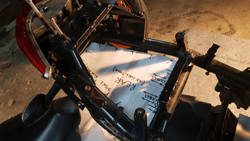
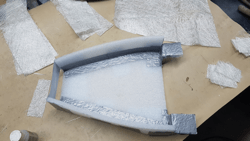
It quickly became apparent that no matter how much I dislike cutting holes where not absolutely necessary and no matter how much I 'squeezed' or moved the controller or how I oriented it (within the constraints that I had) I HAD to cut two holes in the seat support bracket to enable the cables to pass through and, thereby, allow the controller to move far enough forward to facilitate access to the tail lights. In this case though I couldn't see how the holes would weaken the overall structure so... I cut the holes, rust proofed them, glossed over and trial fitted the controller...


All looked good so the next step was to mount the controller and the two SSRs with their heatsinks. I guess the 'norm' here is to use HV contactors / relays but Solid State Relays use so little power when 'On' and have the advantage of being so very flexible with their energising voltage that I thought I'd give them a go. They have worked great in other projects (like my Spot Welder) so they deserved a chance here too... especially as, having no moving parts, there can be no contact bounce / accidental disconnect due to the higher vibration of the scooter... Anyways, I gave them a go !
Two of them, one for the low voltage (12V) / controller energising and one for the high voltage, (72V) motor.
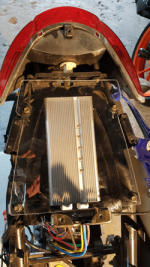
The recently removed fuel tank had been through-bolted at four points - top and bottom left and right of the recently-fitted controller tray. These were to be re-tasked to locate the "ancillary components shelf" which (because it allows me to see the controller & SSRs below and because (I think) it looks super cool - not that, when all the fairings are back in place, it will be visible !) was to be made form 8mm clear Acrylic sheet...
After test fitting the controller tray and acrylic 'shelf' it was time to drill 2 additional (corner) holes in the tray for drainage (there's just bound to be some water ingress) and finally fix it to the scoot frame.
I ended up with the painted black, GRP tray housing the controller, the 2 x SSRs and their heat sinks. The tray is angled down toward the front of the scoot (towards the bottom of the image); this is where the 2 x 10mm drain holes are situated.
The SSRs screw to their (black) heat sinks and the heatsinks are through-screwed into the base of the controller tray. The two holes previously drilled in the seat-lock bracket enable the controller HV input (thick red and black) and motor phase cables (thick blue, yellow and green) - both right hand lower corner, together with the control cables (thinner, multi-coloured) - left hand lower corner, to exit the controller tray without chafing etc...
Now, things began to move really quickly !
This was the part I'd been really looking forward to !!
The first job was to finish siting the SSRs and connect the 2 x battery hook-up cables (terminated with Anderson connectors) The DCDC convertor was fitted next, followed by the Li-Ion 12V battery, the shunt (I think I'm going to want to know charge / discharge current and voltage etc) and then fuse holders. I added a pair of (red / black) banana connector sockets to measure the battery / DCDC convertor voltage and to connect an external 12V source / charger in case of 'flat battery'.
Two SSRs :
... both energised by the Li-Ion battery via its fuse, the ignition switch and the kill switch.
One 10A SSR (left hand side) for the low voltage (12V). This unit feeds 72V to the DCDC convertor.
One 60A SSR (right hand side) for the high voltage (72V, motor / controller). This unit feeds battery pack 72V to the LV / 10A SSR (which feeds the DCDC convertor) and the controller.
One DCDC Convertor :
Connections to the HV SSR output, shunt ground and the 12V fused rail.
One diode :
In-line between the fused 12V rail and the Li-Ion battery The purpose of the diode is to enable Li-Ion battery pack charging whilst preventing back-flow from the battery to any on-board items - except the DCDC convertor (for charging)
Three fuses :
DCDC convertor (all onboard 12V)
Ignition / controller enable (basically, kill switch OFF and Ignition switch ON puts 12V onto the 'power lock' / controller enable.
Onboard lighting / horn electrics
One shunt :
One side of the shunt was connected to both battery -ves, whilst the other side was connected to motor controller -ve, DCDC convertor -ve and chassis ground.
Final steps : the motor cables (green, blue & yellow) were connected via a 50A terminal block to the controller. The controller / motor hall sensor connections were made (plug'n'play)...
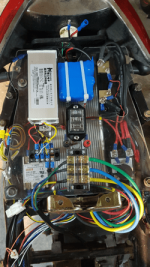
... and then onto the throttle, brake, reverse and power lock cables... but those are for tomorrow... (mostly because it's late and I note that the throttle cable is terminated with a different plug-type to the controller socket !
To be frank, I also have :
the High / Low speed connector to make (naturally I only need the HIGH !) but (if only for testing) i'd better make a PAIR of connectors - one for Hi and another for Lo speed - or I could add a Hi/Lo switch...
the 'fuel filler' / charge port to connect. I have designed it (SketchUp) printed it (3D Printer), fitted the matching 72V charge connector into it and test fitted it on the scoot but I need to add the diode protection, connect up and fit it...
dry test the lot...
reassemble the scoot and let my son test it for me... receive his 'review' / critique and...
and... probably, a load of other small jobs I haven't remembered to write down here...
The original ICE kit has been removed.
The original wiring has been serviced / repaired / updated to remove no-longer required cabling and modified to re-task cabling to suit the new electrics and add any new / additional cabling for the imminent electric conversion.
The 3Kw BLDC electric motor has been fitted on a custom, adjustable, aluminium bracket and the cabling routed aft and up to the intended controller position.
The belt driven vari-drive has been modified for a chain drive with rear sprocket and the clutch has been left insitu (to start off with but I have my doubts here...).
All lighting has been switched to LED.
The battery pack tray has been built and installed.
The 2 x 72V, 1KW battery backs have been built, charged and tested.
The fuel filler cap has been replaced with a 3D printed charge point complete with waterproof cap (still need to update here with pics etc).
The next step was to design and build the controller 'tray' and then mount the controller before adding a 2nd tier shelf arrangement on which to mount the other electrical / electronic components (fuses, relays, DCDC convertor, 12V battery etc) and connecting the systems up prior to testing. Now it's becoming exciting...

Controller tray
Now that the batteries were sited directly above the motor, there was enough space (with a little modification) to site the controller (and ancillary parts) in lieu of the petrol tank / aft of the rider's seat. This are is a quite 'unforgiving' space in that the rear wheel is directly below (don't go too deep) and the fairings are immediately above (don't come too high). To boot, access to the rear / brake light is from this area too (don't go too far aft) and the front end is limited by the seat-lock bracket (don't come too fare forward)... BUT... all-in-all this is controller space !! Dry and well cooled...
Having decided all would be well, I set to designing and fabricating the tray. This was no job for SketchUp or the 3D printer - just cardboard, scissors and tape before moving on to foam and then fabrication with fibreglass...


It quickly became apparent that no matter how much I dislike cutting holes where not absolutely necessary and no matter how much I 'squeezed' or moved the controller or how I oriented it (within the constraints that I had) I HAD to cut two holes in the seat support bracket to enable the cables to pass through and, thereby, allow the controller to move far enough forward to facilitate access to the tail lights. In this case though I couldn't see how the holes would weaken the overall structure so... I cut the holes, rust proofed them, glossed over and trial fitted the controller...


All looked good so the next step was to mount the controller and the two SSRs with their heatsinks. I guess the 'norm' here is to use HV contactors / relays but Solid State Relays use so little power when 'On' and have the advantage of being so very flexible with their energising voltage that I thought I'd give them a go. They have worked great in other projects (like my Spot Welder) so they deserved a chance here too... especially as, having no moving parts, there can be no contact bounce / accidental disconnect due to the higher vibration of the scooter... Anyways, I gave them a go !
Two of them, one for the low voltage (12V) / controller energising and one for the high voltage, (72V) motor.

The recently removed fuel tank had been through-bolted at four points - top and bottom left and right of the recently-fitted controller tray. These were to be re-tasked to locate the "ancillary components shelf" which (because it allows me to see the controller & SSRs below and because (I think) it looks super cool - not that, when all the fairings are back in place, it will be visible !) was to be made form 8mm clear Acrylic sheet...
After test fitting the controller tray and acrylic 'shelf' it was time to drill 2 additional (corner) holes in the tray for drainage (there's just bound to be some water ingress) and finally fix it to the scoot frame.
I ended up with the painted black, GRP tray housing the controller, the 2 x SSRs and their heat sinks. The tray is angled down toward the front of the scoot (towards the bottom of the image); this is where the 2 x 10mm drain holes are situated.
The SSRs screw to their (black) heat sinks and the heatsinks are through-screwed into the base of the controller tray. The two holes previously drilled in the seat-lock bracket enable the controller HV input (thick red and black) and motor phase cables (thick blue, yellow and green) - both right hand lower corner, together with the control cables (thinner, multi-coloured) - left hand lower corner, to exit the controller tray without chafing etc...
Now, things began to move really quickly !
This was the part I'd been really looking forward to !!
The first job was to finish siting the SSRs and connect the 2 x battery hook-up cables (terminated with Anderson connectors) The DCDC convertor was fitted next, followed by the Li-Ion 12V battery, the shunt (I think I'm going to want to know charge / discharge current and voltage etc) and then fuse holders. I added a pair of (red / black) banana connector sockets to measure the battery / DCDC convertor voltage and to connect an external 12V source / charger in case of 'flat battery'.
Two SSRs :
... both energised by the Li-Ion battery via its fuse, the ignition switch and the kill switch.
One 10A SSR (left hand side) for the low voltage (12V). This unit feeds 72V to the DCDC convertor.
One 60A SSR (right hand side) for the high voltage (72V, motor / controller). This unit feeds battery pack 72V to the LV / 10A SSR (which feeds the DCDC convertor) and the controller.
One DCDC Convertor :
Connections to the HV SSR output, shunt ground and the 12V fused rail.
One diode :
In-line between the fused 12V rail and the Li-Ion battery The purpose of the diode is to enable Li-Ion battery pack charging whilst preventing back-flow from the battery to any on-board items - except the DCDC convertor (for charging)
Three fuses :
DCDC convertor (all onboard 12V)
Ignition / controller enable (basically, kill switch OFF and Ignition switch ON puts 12V onto the 'power lock' / controller enable.
Onboard lighting / horn electrics
One shunt :
One side of the shunt was connected to both battery -ves, whilst the other side was connected to motor controller -ve, DCDC convertor -ve and chassis ground.
Final steps : the motor cables (green, blue & yellow) were connected via a 50A terminal block to the controller. The controller / motor hall sensor connections were made (plug'n'play)...

... and then onto the throttle, brake, reverse and power lock cables... but those are for tomorrow... (mostly because it's late and I note that the throttle cable is terminated with a different plug-type to the controller socket !
To be frank, I also have :
the High / Low speed connector to make (naturally I only need the HIGH !) but (if only for testing) i'd better make a PAIR of connectors - one for Hi and another for Lo speed - or I could add a Hi/Lo switch...
the 'fuel filler' / charge port to connect. I have designed it (SketchUp) printed it (3D Printer), fitted the matching 72V charge connector into it and test fitted it on the scoot but I need to add the diode protection, connect up and fit it...
dry test the lot...
reassemble the scoot and let my son test it for me... receive his 'review' / critique and...
and... probably, a load of other small jobs I haven't remembered to write down here...


